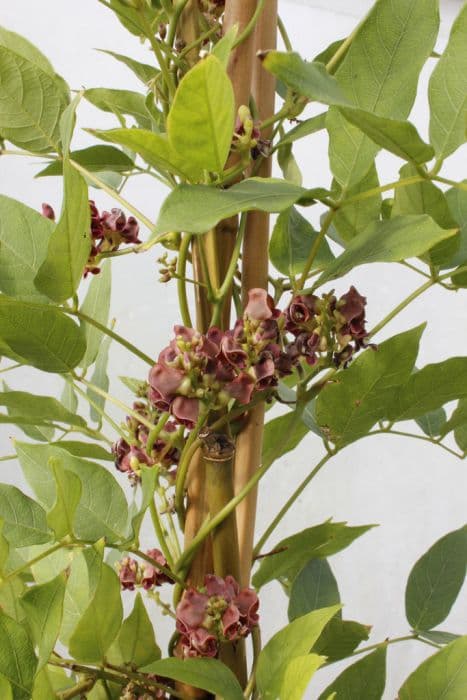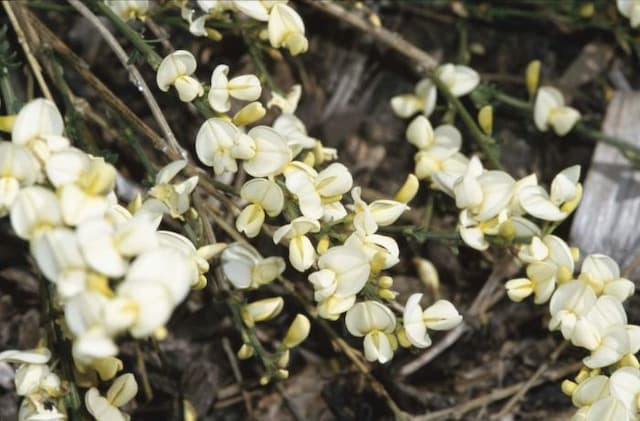Sweet pea Lathyrus odoratus var. nanellus 'Northern Lights Cherub' (Cherub Series)

ABOUT
The plant known as sweet pea presents an enchanting display of delicate flowers that belong to the 'Northern Lights Cherub' from the Cherub Series. This variety is characterized by its soft and pastel-colored blooms which boast intricate and romantic shades. The flowers are typically bicolored, exuding a gradient of hues that may include soft pinks, creamy whites, and gentle lilacs, each petal gracefully fading into the next color. These flowers have a distinctive, ruffled look that adds to their old-world charm, giving them a frilly and whimsical appearance. The sweet pea blooms are renowned for their delightful fragrance, which is both sweet and subtle, contributing to their popularity in gardens and floral arrangements. The foliage of this plant consists of slender, green tendrils and pointed, pinnate leaves that offer a delicate and airy backdrop to the vibrant and aromatic flowers.
About this plant
 Names
NamesSynonyms
Sweet Pea, Perennial Pea, Everlasting Pea, Peavine.
Common names
Lathyrus odoratus var. nanellus 'Northern Lights Cherub'.
 Toxicity
ToxicityTo humans
The plant commonly known as Sweet Pea, which includes varieties like 'Northern Lights Cherub', can be toxic to humans when ingested. Sweet Pea plants contain amino acids called aminopropionitrile that can cause a condition known as lathyrism if consumed in large quantities. Lathyrism affects the muscles and bones, leading to weakness and potentially permanent paralysis. Other symptoms may include lethargy, convulsions, and difficulty in walking. It's important to note that the seeds are particularly toxic if ingested.
To pets
Sweet Pea, including the variety 'Northern Lights Cherub', is also toxic to pets if ingested. The seeds of Sweet Pea plants contain compounds that can cause lathyrism in animals, just as in humans. Symptoms of Sweet Pea poisoning in pets can include vomiting, diarrhea, lethargy, tremors, seizures, and difficulty in walking. In severe cases, it can lead to paralysis or even death, specifically if a large amount of the seeds or plant is consumed. It is crucial to prevent pets from ingesting any part of this plant.
 Characteristics
CharacteristicsLife cycle
Annuals
Foliage type
Deciduous
Color of leaves
Green
Flower color
Mixed
Height
6-8 inches (15-20 cm)
Spread
6-8 inches (15-20 cm)
Plant type
Climber
Hardiness zones
2-11
Native area
Mediterranean
Benefits
 General Benefits
General Benefits- Aesthetic Appeal: Adds vibrant color and beauty to gardens with its delicate flowers that come in a range of colors.
- Fragrance: The sweet pea is well-known for its sweet, pleasant aroma that can enhance the sensory experience of a garden.
- Attracts Pollinators: The flowers attract bees and butterflies, which are important for pollinating other plants in the garden.
- Easy to Grow: Sweet peas are relatively easy to cultivate, which makes them suitable for beginner gardeners.
- Versatile Planting: Can be used in borders, containers, and hanging baskets, providing diversity in garden design.
- Vertical Interest: As a climbing plant, sweet pea can add height and structure to garden spaces when supported by trellises or poles.
- Cut Flowers: The blooms are excellent for cutting and creating fragrant, colorful indoor flower arrangements.
- Quick Cover: The plant can grow quickly, offering a fast way to cover unsightly fences or structures.
 Medical Properties
Medical PropertiesThis plant is not used for medical purposes.
 Air-purifying Qualities
Air-purifying QualitiesThis plant is not specifically known for air purifying qualities.
 Other Uses
Other Uses- Sweet pea can be used in companion planting to help support and enhance the growth of vegetables like beans and tomatoes, with its climbing nature providing a natural trellis.
- The stems of sweet pea, being sturdy and long, can be used in arts and crafts, such as making natural wreaths or for creating supports for other houseplants.
- The flowers of sweet pea are sometimes used in weddings and events for their fragrance and delicate appearance, often in bouquets or table arrangements.
- Dried sweet pea petals can be used in homemade potpourri to add a pleasant scent to your home.
- Fragrant sweet pea blooms are used in the production of natural, plant-based perfumes and scented oils.
- Sweet pea vines can be woven into living fences and privacy screens when grown along hedges or mesh structures.
- The plant can serve as inspiration for artists and photographers due to its vibrant colors and photogenic qualities.
- The flower's nectar is a food source for beneficial garden insects, like bees and butterflies, thereby promoting pollinator health.
- Children can be taught the basics of plant growth and gardening through sweet pea cultivation due to its rapid growth and low maintenance.
- Sweet pea seeds can be used in educational settings as a tool to demonstrate the life cycle of plants from germination to seed production.
Interesting Facts
 Feng Shui
Feng ShuiThe Sweet Pea is not used in Feng Shui practice.
 Zodiac Sign Compitability
Zodiac Sign CompitabilityThe Sweet Pea is not used in astrology practice.
 Plant Symbolism
Plant Symbolism- Blissful Pleasure: Sweet pea, including the Lathyrus odoratus var. nanellus 'Northern Lights Cherub', is often associated with blissful pleasure due to its delightful fragrance and attractive appearance.
- Goodbye or Departure: Sweet pea can symbolize a fond farewell or goodbye, making it suitable for occasions when someone is leaving or emigrating.
- Thank You: The sweet pea has come to express gratitude, making it a perfect gesture of appreciation towards friends or loved ones.
- Delicate Pleasures: With its intricate flowers, sweet pea reflects the theme of enjoying the delicate, fleeting pleasures of life.
- Lasting Pleasure: Contrary to delicate pleasures, sweet pea also symbolizes lasting pleasure, suggesting a memory or experience that will be treasured for a long time.
 Water
WaterSweet peas should be watered deeply and thoroughly to encourage proper root development. It's important to keep the soil evenly moist, especially during dry spells. A good guideline is to provide about 1 gallon of water per week, either through rain or supplemental watering. This may increase to twice a week during prolonged dry periods or in hot climates. Avoid overhead watering to prevent disease; instead, water at the base of the plant early in the day to allow foliage to dry.
 Light
LightSweet peas thrive in a spot with full sun, meaning they should receive at least 6 to 8 hours of direct sunlight per day. An optimal location would provide morning sun and some light afternoon shade in hotter regions to prevent the flowers from fading.
 Temperature
TemperatureSweet peas prefer cooler temperatures and will perform best when daytime temperatures are between 55°F and 65°F. They can survive in temperatures as low as 25°F for short periods, but consistently warm temperatures above 75°F will reduce blooming. Ideal conditions involve cool nights and mild days.
 Pruning
PruningPruning sweet peas, specifically pinching out the growing tips, encourages bushier growth and more blooms. It’s best done when the plants are about 4 to 6 inches tall. Pruning should be performed as needed throughout the growing season to remove faded flowers and seed pods, which encourages continued blooming.
 Cleaning
CleaningAs needed
 Soil
SoilFor Sweet Pea 'Northern Lights Cherub', a soil mix that drains well yet retains moisture is ideal. A good recipe would include equal parts of compost, peat moss, and perlite or vermiculite to ensure aeration and drainage. The pH should be slightly alkaline to neutral, ranging from 7.0 to 7.5.
 Repotting
RepottingSweet Pea 'Northern Lights Cherub' typically does not require frequent repotting, as they are annual plants. They are sown directly into the ground or pots where they will live out their life cycle over a single season.
 Humidity & Misting
Humidity & MistingThe Sweet Pea 'Northern Lights Cherub' prefers moderate humidity levels but adapts to average household humidity. Aim for a humidity level around 40-60% for optimal growth.
 Suitable locations
Suitable locationsIndoor
Ensure bright light, cool temps, and support for climbing.
Outdoor
Plant in full sun, provide a trellis, and protect from strong winds.
Hardiness zone
2-11 USDA.
 Life cycle
Life cycleThe life of Sweet Pea 'Northern Lights Cherub' begins with seed germination, which typically occurs in late winter or early spring when temperatures are consistently above 55°F (13°C). Upon germination, the seedling stage starts with the emergence of the radicle followed by the cotyledons, and then the first true leaves develop as it establishes a root system. As it enters the vegetative stage, the plant grows rapidly, producing compound leaves, tendrils for climbing, and strengthening its stem. The Sweet Pea then transitions into the flowering stage, where it develops vibrant, fragrant flowers in a variety of colors that can attract pollinators such as bees and butterflies. After pollination, the plant produces pods containing seeds during the reproductive stage, completing the life cycle when these seeds mature and are dispersed to begin a new generation. In temperate regions, Sweet Pea 'Northern Lights Cherub' is grown as an annual, meaning it completes its entire lifecycle within one growing season.
 Propogation
PropogationPropogation time
Spring
The most popular method of propagation for the sweet pea Lathyrus odoratus var. nanellus 'Northern Lights Cherub' is through seeds. Ideally, seeds should be sown in late winter or early spring. To improve germination, seeds can be nicked slightly with a sharp knife or soaked in water for several hours before planting. They should be sown in well-draining soil at a depth of about 1 inch (2.54 cm), spaced about 2 to 3 inches (5 to 7.6 cm) apart. It is important to provide support for the plant to climb, as sweet peas are climbing plants. Seedlings typically emerge within 10 to 21 days, depending on soil temperature and conditions.









